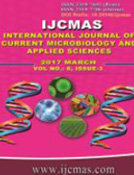


 National Academy of Agricultural Sciences (NAAS)
National Academy of Agricultural Sciences (NAAS)

|
PRINT ISSN : 2319-7692
Online ISSN : 2319-7706 Issues : 12 per year Publisher : Excellent Publishers Email : editorijcmas@gmail.com / submit@ijcmas.com Editor-in-chief: Dr.M.Prakash Index Copernicus ICV 2018: 95.39 NAAS RATING 2020: 5.38 |
A field experiment was carried out to evaluate the economic aspects of sesame cultivation in acidic soil and its management with the application of sulfur and lime during the summer (Kharif) seasons of 2014. The experiment was laid out in factorial randomize block design with four levels of sulfur (0, 15, 30 and 45 kg ha‑1) and four doses of lime (CaCO3) (0, 100, 250 and 350 kg ha‑1). The results indicated that at P=0.05 significantly higher seed (285.75 and 286.08 kg ha‑1) and stalk (359.84 and 358.28 kg ha‑1) yield of sesame was noted with the sulfur and lime level of 30 and 250 kg ha‑1, respectively. The considerably more net return (Rs.18660.89) and B: C ratio (3.65) of sesame was recorded under sesame + guava alley system with application of 30 kg S ha-1 over the sole cropping of sesame. Similarly, on lime levels, the higher net returns (Rs.19642.72) and B: C ratio (3.81) of sesame was observed under sesame + guava alley system with application of 250 kg lime ha-1. Although, under alley system the seed yield, stalk yield, net return, and B: C ratio of the sulfur and lime levels of 30 and 250 kg ha‑1were at par with 45 kg S and 350 kg lime ha-1, respectively. Sesame + guava alley system had a more monetary advantage over sole cropping of sesame.
 |
 |
 |
 |
 |